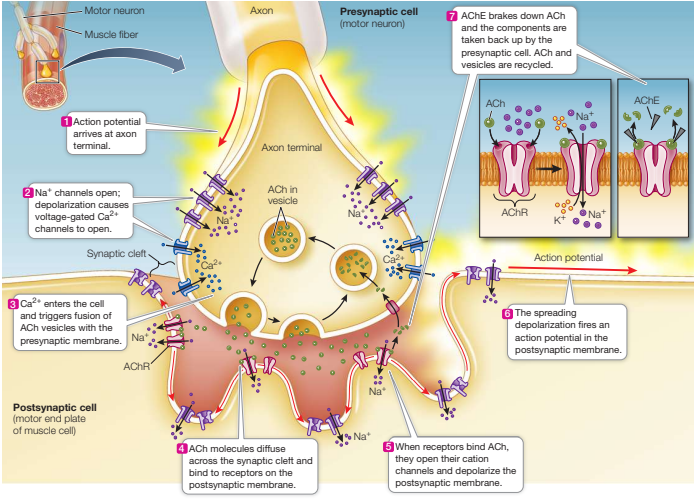BIOL10008: Homeostasis and Communication
1/20
Earn XP
Description and Tags
Concept 20
Name | Mastery | Learn | Test | Matching | Spaced |
|---|
No study sessions yet.
21 Terms
What is homeostasis? What is a set point?
The maintenance of a relatively constant internal environment in response to the external environment (a stimulus)
Stimulus → receptor → control centre → effector
set point - physiological value around which the normal range fluctuates (ex: body temp at 37 degrees)

What is positive feedback? Give examples.
Occurs when a product of a process stimulates the increase of its production - amplifies a response
Ex:
Blood clotting: Cut in blood vessel wall causes nearby platelets to secrete chemical signals to attract more platelets to the site, initiating a blood clot, platelets continue to secrete signals until the developing clot seals off the wound
Birth process: Contractions of the uterus push the baby into the birth canal, and stretching of the birth canal stimulates more and stronger contractions until the baby is delivered, at which time contractions cease
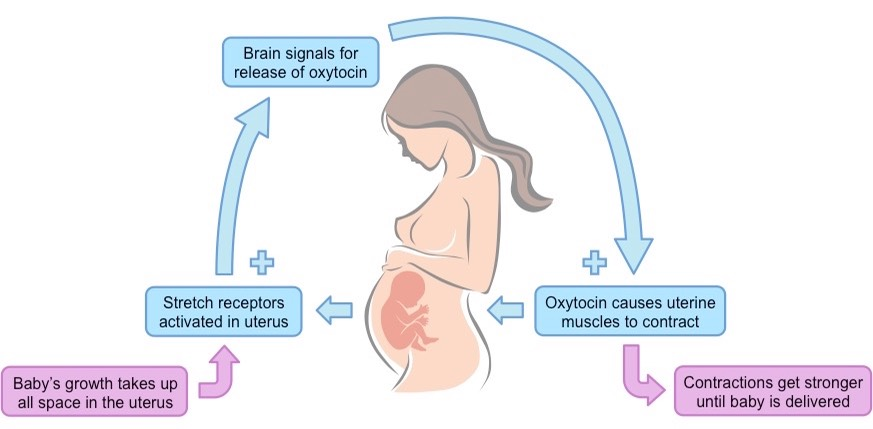
What is negative feedback? Give examples.
Occurs when the product of a reaction reduces the initial stimulus, counteracts the influence of the stimulus
Ex:
High blood glucose: pancreas releases insulin, triggering glucose uptake by liver cells which reduces blood glucose levels, once blood glucose levels are restored, pancreas stops production of insulin
Sweat in response to high body temperature
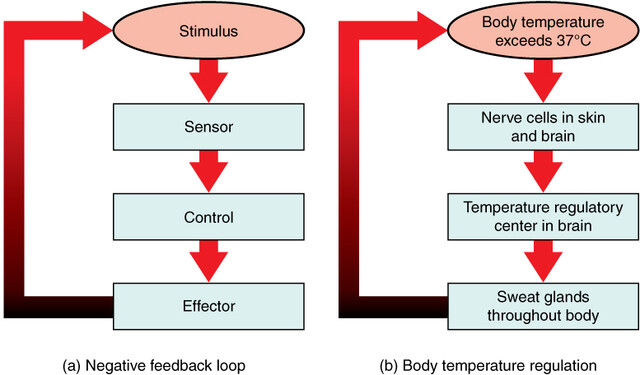
What is contact-dependent signalling?
Communication between physically linked cell
Deliver signals through gap junctions in animal cells or plasmodesmata in plant cells
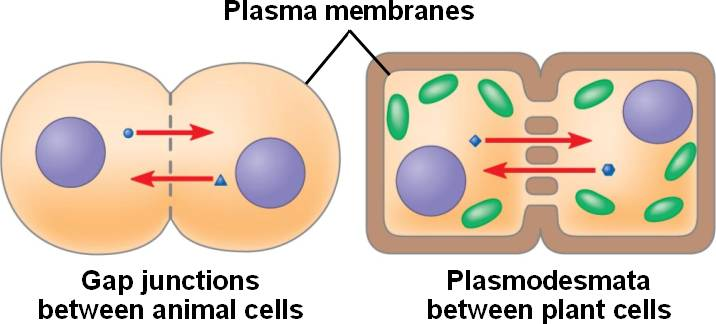
What is the difference between hypoglycaemia and hyperglycaemia?
Hypoglycaemia (low blood glucose levels)
affects nervous system causing seizures and loss of consciousness
Hyperglycaemia (high blood glucose levels)
damages cells leading to heart disease, stroke, kidney disease, vision impairment
What is the homeostatic response when blood glucose is high?
B-cells in the pancreas detect high blood sugar levels and release insulin into the blood
This causes the glucose to be taken up by the liver and converted and stored as glycogen
Body cells also take up glucose to be utilised in cellular respiration - glycolysis
Once blood glucose levels return to homeostasis, insulin release stops and insulin concentration decreases

How does insulin stimulate liver cells to store glucose as glycogen?
insulin is a hydrophilic molecule and thus cannot diffuse through the PM
Insulin binds to insulin receptors on a liver cell, causing autophosphorylation to occur which initiates a signalling pathway
increases the number of glucose transporters in the membrane, resulting in increased diffusion of glucose into the liver cell
activates glucokinase which phosphorylates glucose and, inhibits activity of glucose-6-phosphotase (removes a phosphate group from glucose), preventing glucose from diffusing out the cell
activates glycogen synthase which converts glucose to glycogen
This leads to the conversion of glucose to glycogen

What is the homeostatic response when blood glucose is low?
a-islet cells in the pancreas release glucagon into the bloodstream
Glucagon acts on the liver, stimulating it to break down glycogen into glucose, which is then released into the bloodstream
This causes blood sugar levels to increase and glucagon secretion to decrease, as the system returns to homeostasis

How does glucagon stimulate glucose release?
glucagon binds to a glucagon g-protein coupled receptor
This results in the initiation of a signalling pathway which:
activates glycogen phosphorylase - breaks glycogen down into glucose
inhibits glycogen synthase activity
Due to a lower insulin concentration, glucose-6-phosphotase activity increases and glucose kinase activity decreases, allowing glucose released from glycogen to diffuse out the cell
This results in the reduction of stored glycogen and the increased release of glucose, increasing blood glucose levels

Communication with hormones. Describe differences between plants and animals
Slower than chemical signals but longer lasting
Plant Hormones:
respond to various stimuli (external + internal)
Light, day length, temp, gravity, nutrients, water
Six types/classes
Can be synthesised in many locations and often play multiple regulatory roles
Animal Hormones
hydrophilic and lipophilic
transported through blood
Produced by specific glands or cells and have specific effects
Have overlapping systems
What are the 6 types of plant hormones?
Functions include growth and development, seed dormancy, defence against herbivores, stress responses, etc.
Abscisic acid
Auxins
Brassinosteroids
Cytokinins
Ethylene
Gibberellins
Some overlap in function - Auxins, Brassinosteroids and Gibberellins promote stem growth
Some work synergistically, while others work antagonistically
Ex: ABA promotes seed dormancy, gibberellins promote seed germination
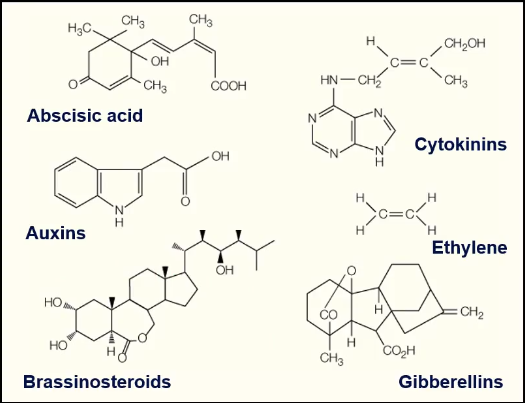
How does stomata respond to various stimuli? (CO2 concentration, light, air humidity, water availability)
CO2 Concentration
When CO2 levels are low, stomata open to allow more CO2 to diffuse into the plant for photosynthesis
Light
when light is detected by guard cells, stomata open
Air Humidity
in low humidity, transpiration rates increase and stomata respond by closing
Water Availability
when root and shoot cells detect reduced water availability they produce the hormone abscisic acid (ABA)
ABA moves through the xylem then binds to ABA receptors, initiating a signal transduction pathway which regulates different ion channels, increasing water potential and causing water to more out of stomata through guard cells
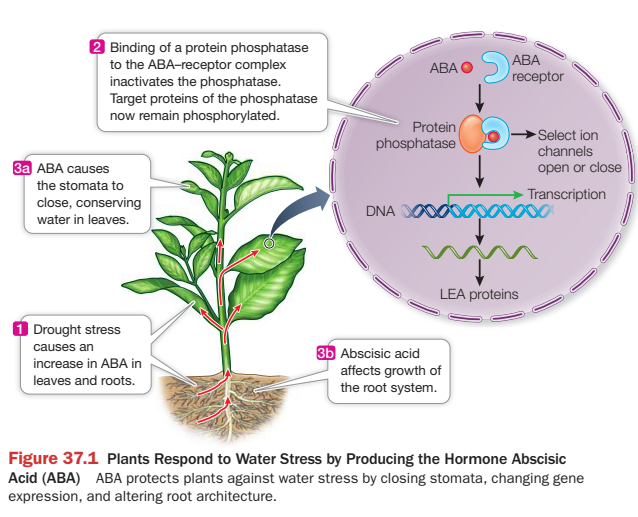
How do plants respond to water stress?
Under dry conditions, there is increased transpiration and reduced water uptake
Under a hot, windy day, there is reduced water in the atmosphere and the soil, creating a negative water potential which results in increased transpiration from the leaves. This reduced water uptake will cause the plant to become dehydrated, and if this continues, plant cells will become damaged
Changes in water potential causes cells in the roots and leaves to produce abscisic acid (ABA)
ABA is translocated to the guard cells where it accumulates at high levels
Due to ABA accumulating, there is an increased water potential caused by the initiation of a signal transduction pathway:
Efflux of anions out of guard cells mediated by anion channels - causes depolarisation
Efflux of K+ out of guard cells by facilitated diffusion through membrane channels
This results in lower K+ and anion concentrations in guard cells, allowing water to move out of guard cells through osmosis
Guard cells consequently loose turgor (become flaccid) and stomata close

Summarise the drought responses of plants to prolonged abscisic acid (ABA) exposure
ABA causes stomata to close, conserving water in leaves
The signalling pathway also causes the expression of drought response genes which lead to increased root growth, reduced shoot growth - allowing the plant to extract more water from soil
Due to extreme water deficits, the membrane integrity is reduced, which may affect the folding of proteins in the ribosomes where they can become clumped together and lose function. To mitigate these effects, the pathway activates genes which encode for hydrophobic proteins. These proteins then bind to membrane proteins and other cellular proteins to stabilise them, preventing clumping and thus maintaining activity.
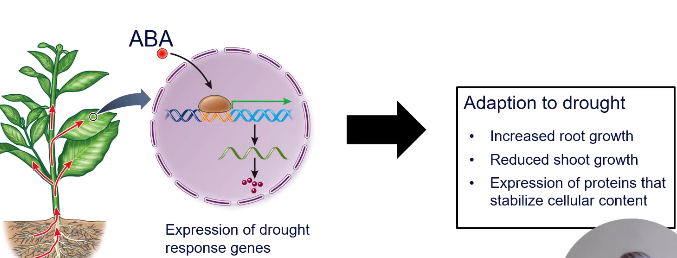
What are neurons? Describe the structure of neurons.
Cells that transmit electrical signals
Cell Body (Soma) - contains the nucleus and most of the cell’s organelles
Dendrites - highly branched projections that receive signals from adjacent neurons at synapses
Axon - carry information from the cell body to target cells, often wrapped in a fatty myelin sheath which insulates the axon and helps to maintain the signal
Nodes of Ranvier - gaps in the myelin sheath where the action potential is repeatedly regenerated as it moves down the axon
Axon hillock - where the cell body meets the axon, generates the action potential
Axon terminal - contains synaptic vesicles filled with neurotransmitters, when action potential reaches the terminal, neurotransmitters are released into the synaptic cleft
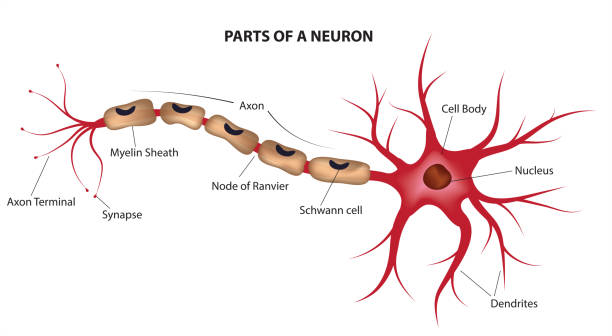
What is the resting membrane potential?
the difference in electrical charge, or voltage, between the inside and the outside of a cell membrane at rest is usually negative at -70mV
more sodium ions (Na+) outside than inside the neuron
more potassium ions (K+) inside than outside the neuron
This negative resting membrane potential is maintained through:
a passive (leaky) potassium channel where K+ ions diffuse out
a sodium-potassium pump that pumps K+ back in the cell and Na+ out at the same time
What are the stages of an action potential?
The resting action potential is -70mV due to leaky K+ channels
Slight depolarisation (action potential increase) causes some voltage-gated Na+ channels open, depolarising the cell to the threshold
Leaky K+ channels remain open and further depolarise the cell
At the threshold of excitation, additional voltage gated Na+ channels open and Na+ ions diffuse into the neuron (due to concentration gradient). This causes a rapid spike in the membrane potential to a maximum peak of +40mV
Na+ channels inactivate and prevent more Na+ from diffusing in the neuron. Voltage-gated k+ channels open and allow K+ to diffuse out down its concentration gradient
As K+ ions continue to exit, the cell becomes repolarised, reducing the membrane potential
The membrane potential overshoots its resting value, becoming briefly hyperpolarised before returning to resting potential
Voltage-gated K+ channels close and voltage-gated Na+ channels reset

Explain the significance of the refractory period in an action potential
Gives the neuron time to replenish the packets of neurotransmitter found at the axon terminal, so that it can keep passing the message along
What is the synapse?
Point at which two neurons meet
When action potential reaches the axon terminal, the presynaptic cell releases neurotransmitters into the synaptic cleft to be received by the postsynaptic cell
are either excitatory or inhibitory depending on the neurotransmitter released
major excitatory neurotransmitter is glutamate
The major inhibitory neurotransmitter is GABA
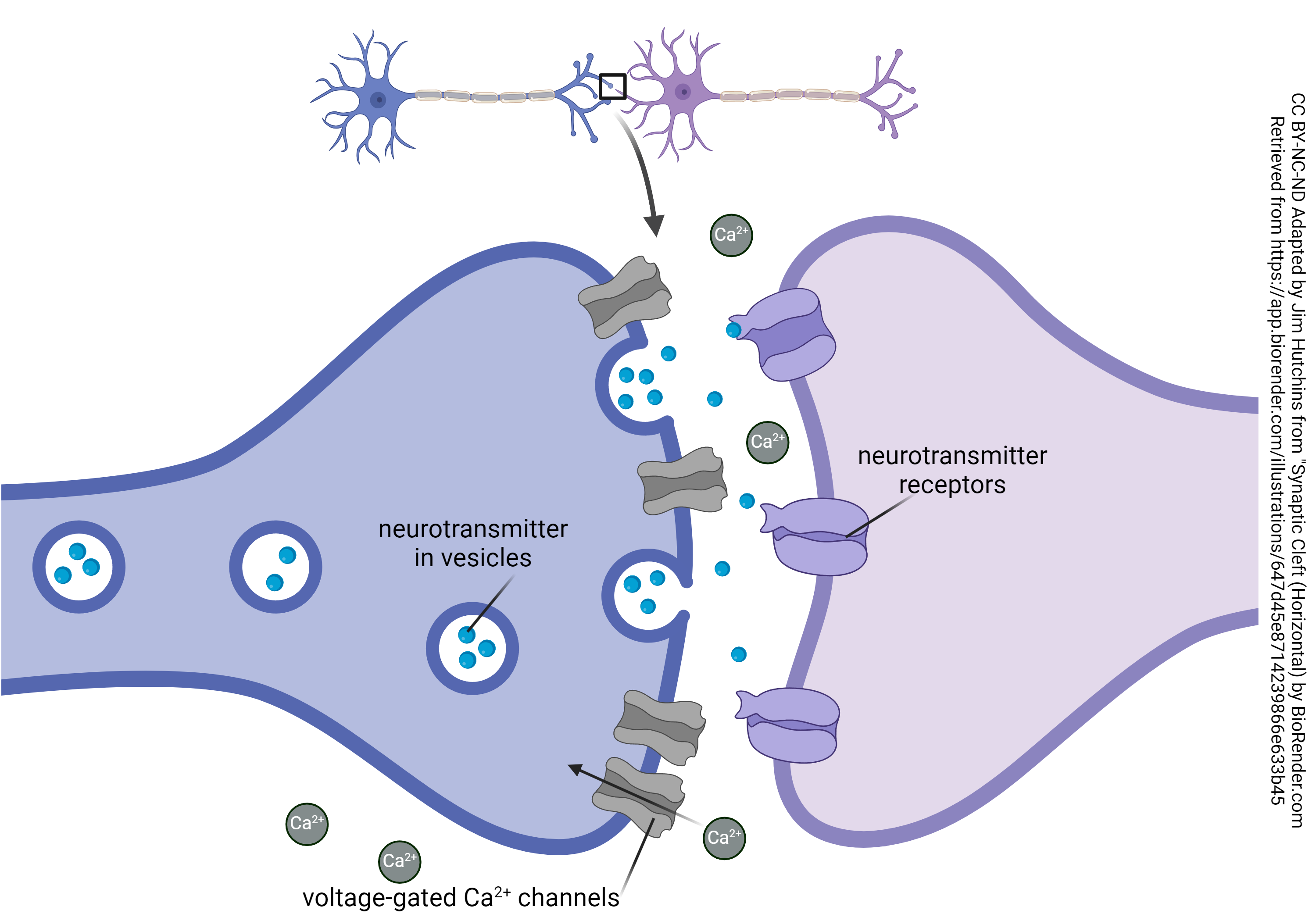
Describe and summarise the role of chemical signalling at the synaptic cleft
Action potential arrives at axon terminal and depolarises the membrane as Na+ channels open
depolarization causes voltage-gated Ca2+ channels to open and Ca2+ enters the cell
This triggers fusion of vesicles with the presynaptic membrane and the subsequent release of neurotransmitters into the synaptic cleft
Neurotransmitters diffuse across the synaptic cleft and bind to receptors on the postsynaptic membrane.
Binding of neurotransmitters to receptors may have an excitatory or inhibitory effect on the initiation of an action potential in the postsynaptic cell
After binding, neurotransmitters either diffuse away, be degraded or get recycled by reuptake proteins from the presynaptic cell
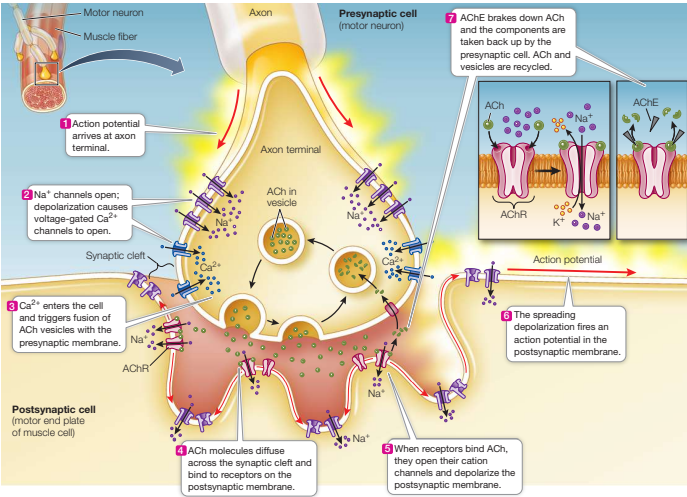
What happens to the neurotransmitter acetylcholine (Ach) as it diffuses into the synaptic cleft?
Ach molecules diffuse across the synaptic cleft and bind to receptors on the postsynaptic membrane
When receptors bind ACh, they open their cation channels and depolarize the postsynaptic membrane
The spreading depolarization fires an action potential in the postsynaptic membrane
AChE brakes down ACh and the components are taken back up by the presynaptic cell. ACh and vesicles are recycled
The breakdown products (acetate and choline) are taken up by the presynaptic membrane and resynthesized into more ACh
